Article contents
Hyperfine Polarization Structure of Jupiter’s Radio Bursts
Published online by Cambridge University Press: 25 April 2016
Extract
Observations of Jupiter’s decametric radio burst have established that above 20 MHz more than 90% of the emission is elliptically polarized in the RH sense, but below this frequency the proportion of the LH polarization increases (Sherrill 1965) until at 10 MHz nearly 40% of the emission is LH polarized (Dowden 1963). The best time and frequency resolutions so far obtained when examining the polarization of the spectra of Jupiter’s bursts have been 10 ms and 50 kHz respectively (Gordon and Warwick 1967, Riihimaa 1975). To study the fine structure of Jupiter’s emission as observed by the linearly polarized Llanherne low frequency radio telescope (Ellis 1972), spectrum analysers with resolutions in the ranges 0.3 — 1 msec and 2–10 kHz have been used (Ellis 1973a, 1973b, 1974, 1975). A new telescope at Llanherne, which is capable of detecting the RH and LH circular components of incident radiation, is being used in conjunction with these analysers to yield information of the hyperfine polarization structure of Jupiter’s decametric radio emission. This paper is a preliminary report of this investigation.
- Type
- Contributions
- Information
- Publications of the Astronomical Society of Australia , Volume 3 , Issue 1 , September 1976 , pp. 49 - 51
- Copyright
- Copyright © Astronomical Society of Australia 1976
References
- 2
- Cited by


